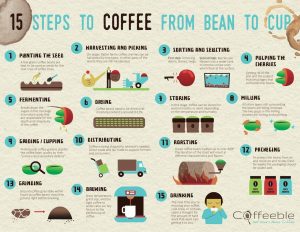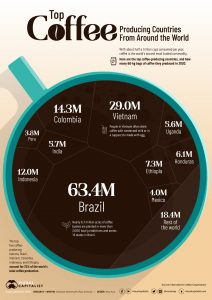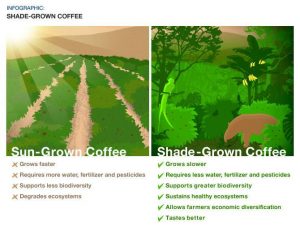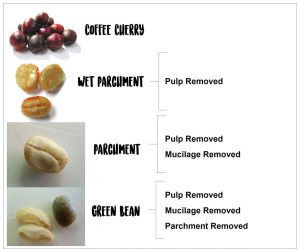The Impact of A Sip of Coffee
Written by: Erin Yoo
Each morning, my dad would prepare a cup of coffee in his Thermos to take to work. It is a decades-old habit, as steady as the sun rising and setting, that he shares with billions of other people around the world (Okafor, 2021). Although people only drink a small cup of coffee each day, the portions add up to a lot over a long time. Consumer demand for coffee has increased over the last few decades, resulting in producers scrambling to find more efficient methods to grow and harvest coffee beans – methods that have come at the cost of the environment.
How Coffee is Made
Coffee travels a long way before making it into Starbucks cups and thermoses, as seen in Figure 1. Its journey starts with local farmers in coffee-producing countries like Brazil and Colombia (see Figure 2) who plant and harvest coffee crops. On the plants are coffee cherries, which house the actual coffee beans that turn into liquid coffee. The outer pulp of the cherries must be removed and fermented until only the beans are left to dry (Moore 2021). From there, the beans are roasted and ground to create the beloved drink.
Figure 1

The steps of coffee production.
Source: [Coffee Bean Corral]
Figure 2

Top coffee producers of the world.
Source: [Visual Capitalist]
Environmental Impact of Coffee Production
The coffee industry has a significant environmental impact due to its sheer size and the inherent environmentally invasive nature of agriculture. Perhaps the most obvious place of improvement of coffee consumption is switching away from disposable single-use plastic cups, filters, and coffee pods. However, plastic pollution is far from the main impact of coffee production. In fact, most carbon emissions from the industry come not from the consumption aspect but cultivation of crops (Okafor 2021).
Coffee plants grow in tropical and subtropical climate which are delicate ecosystems (Okafor 2021, Moore 2021). This means that over planting coffee plants can have dramatic effects on the ecosystem and the other communities that live within it. Until the 1970s, coffee was usually grown in the shade of tree canopies which is considered to be relatively eco-friendly. In fact, the head of Rainforest Alliance, a conservation organization, considers shaded coffee farms to be “the next best thing to rainforests” (Okafor 2021).
However, a new technique was developed in the late twentieth century to meet growing market demand for coffee, known as sun-cultivation. This method involves clearing land to plant coffee crops directly under the sun which has a higher agricultural yield than the traditional method (Okafor 2021). In other words, it takes less land and labor to harvest more coffee beans using this technique. Just a little over a decade ago, a study found that over 75% of coffee farms in Brazil and Vietnam, some of the largest coffee producers in the world, used sun-cultivation (Okafor 2021).
The effects of this more intensive agricultural process include deforestation, soil degradation, habitat loss, and pollution. For instance, 37 out of the top 50 countries (74%) with the highest deforestation rates are major coffee producers (Okafor 2021). In addition, the new method decreases biodiversity, since the only crops on sun-cultivation farms are coffee plants, and reduces soil quality. The lack of tree cover also facilitates soil erosion. As a result, some estimates suggest that although the method is efficient now, half of all coffee-producing land will be unproductive by 2050 (Okafor 2021).
Figure 3

A comparison of sun cultivation and shade cultivation of coffee.
Source: [Sustainable Business Toolkit]
Sun-cultivation also makes it easier for pests to invade crops which forces farmers to increase their use of pesticides and fertilizers. These chemicals then make their way to the air, soil, and groundwater and contaminate the environment (Okafor 2021). Further, enormous amounts of crops are wasted when coffee cherries are depulped to isolate the coffee beans because everything except for the beans, like the pulp and residual matter, are thrown away (see Figure 4). This waste gets thrown into rivers, which causes eutrophication which damages marine life by taking away oxygen. (Okafor 2021).
Figure 4

The stages from coffee cherry to coffee bean.
Source: [The Coffee Blog]
Coffee can even pollute waterways after consumption. When coffee grounds are thrown away, caffeine can seep into the environment. Additionally, 2-3% of caffeine that a person consumes makes it into the sewage system. Afterward, water treatment facilities cannot completely filter out the pollutant before the water is returned back to communities (Okafor 2021).
Of course, the consumer side of the multibillion coffee industry also results in waste and thus environmental harm through the use of single-use plastic and electric brewing machines (Okafor 2021). One study done by a natural resource institute in Finland found that coffee waste is the third largest category of household waste (Okafor 2021). Although one solution to the plastic problem is using recyclable cups, the technology needed to recycle plastic is not widely available so a significant portion of recycled cups still end up in landfills (Okafor 2021). The damage inflicted by the coffee industry onto the climate then makes it harder to grow coffee. Put simply, sun-cultivation and other unsustainable practices mean coffee producers and companies are harming themselves in the long run.
Reimagining Coffee
One coffee startup based in Seattle, which is, interestingly enough, also where Starbucks was created, believes that there is no sustainable coffee-production method possible that can meet coffee’s current demand (Giles 2021). Consequently, they reimagined the idea of coffee by replacing coffee beans with other ingredients. They aim to create coffee by using the pits, stems, and seeds of plants – parts which are commonly discarded and ignored. They experimented with watermelon and sunflower seeds, for example, before finally landing on using date seeds (Atomo n.d., Giles 2021).
Their method uses 94% less water and results in 93% less carbon emissions compared to standard industry practices, as stated on their website (Atomo n.d.). With the innovation of companies like Atomo, the coffee industry can find more sustainable alternatives to meeting the high demand for coffee.
Figure 5

Atomo coffee products (not available for purchase yet).
Source: [Atomo Coffee]
Conclusion
Although the coffee industry is responsible for soil erosion, deforestation, and lack of biodiversity, this doesn’t mean that coffee production in its current form must be completely eliminated. It just means the current state of coffee production must be scaled back.
Oftentimes, calls for sustainable practices may seem like advocating for total reversal of existing systems, but that is not true. There are many benefits to the current coffee industry: mass employment, the preservation of an ancient Ethiopian drink, and the culture of cozy coffee shops and reliable morning routines. The same goes for other sectors like the fossil fuel industry. But, the point is that it is possible to both preserve current traditions and build a greener, more comfortable future. The world does not have to entirely switch to Atomo coffee and forget other traditional breweries, but it’s still important to encourage the creativity of such sustainability innovators. Without them, we’d eventually run out of coffee.
References and Sources
Atomo. (n.d.). Coffee. Atomo. https://www.atomocoffee.com/coffee
Environmental effects of coffee production. (n.d.). The World Counts. https://www.theworldcounts.com/challenges/consumption/foods-and-beverages/environmental-effects-of-coffee-production/story
Giles, J. (2021, June 3). Q2 startup roundup. Food Weekly. https://www.greenbiz.com/article/second-quarter-food-startup-roundup
Moore, V. (2021, May 21). The Environmental Impact of Coffee Production: What’s Your Coffee Costing The Planet? Sustainable Business Toolkit. https://www.sustainablebusinesstoolkit.com/environmental-impact-coffee-trade/
Okafor, J. (2021, September 14). Coffee – Environmental Impact of our Caffeine Habit. TRVST. https://www.trvst.world/sustainable-living/coffee-environmental-impact/
1 thoughts on “The Impact of A Sip of Coffee”